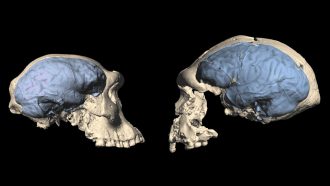
Even after ancient humans took their first steps out of Africa, they still unexpectedly may have possessed brains more like those of great apes than modern humans, a new study suggests.
For decades, scientists had thought modern humanlike organization of brain structures evolved soon after the human lineage Homo arose roughly 2.8 million years ago (SN: 3/4/15). But an analysis of fossilized human skulls that retain imprints of the brains they once held now suggests such brain development occurred much later. Modernlike brains may have emerged in an evolutionary sprint starting about 1.7 million years ago, researchers report in the April 9 Science.
What sets modern humans apart most from our closest living relatives, the great apes, is most likely our brain. To learn more about how the modern human brain evolved, the researchers analyzed replicas of the brain’s convoluted outer surface, re-created from the oldest known fossils to preserve the inner surfaces of early human skulls. The 1.77-million to 1.85-million-year-old fossils are from the Dmanisi archaeological site in the modern-day nation of Georgia and were compared with bones from Africa and Southeast Asia ranging from roughly 2 million to 70,000 years old.
The scientists focused on the brain’s frontal lobes, which are linked with complex mental tasks such as toolmaking and language. Early Homo from Dmanisi and Africa still apparently retained a great ape–like organization of the frontal lobe 1.8 million years ago, “a million or so years later than previously thought,” says paleoanthropologist Philipp Gunz at the Max Planck Institute for Evolutionary Anthropology in Leipzig, Germany, who did not take part in this study.
These findings reveal early humans may have possessed relatively primitive brains even after they first began dispersing from Africa some 2.1 million years ago (SN: 7/11/18). Modern humans started migrating from the continent about 210,000 years ago (SN: 7/10/19). Still, it is essential to not underestimate the mental capabilities of early humans, says Marcia Ponce de León, a paleoanthropologist at the University of Zurich. “These people ventured out of Africa, produced a variety of tools, exploited animal resources and cared for elderly people, as we know from the site of Dmanisi,” she says.
She and colleagues discovered that modern human–like brain organization started appearing in Africa between about 1.5 million to 1.7 million years ago. “I don’t know about anyone else, but I’ve just developed a keen interest in learning everything possible about what hominins were doing during [those] 200,000 years” that drove the brain change, says paleoanthropologist Dean Falk at Florida State University in Tallahassee, who did not take part in the study.
The scientists also found that hominids with modern human–like brains appeared in Southeast Asia shortly after 1.5 million years ago, which hints at another dispersal from Africa separate from the first migration about 2.1 million years ago, Ponce de León says. It remains uncertain whether this second wave merged with or replaced the earlier groups, the researchers note.
Much remains controversial about reconstructing the organization of ancient brains from skulls, cautions paleoanthropologist Bernard Wood at George Washington University in Washington D.C., who did not take part in this study. For example, it can prove challenging deducing how the insides of fossil braincases reflected bumps and grooves on the brain’s surface, or what the consequences of such brain organization might have had on brain function (SN: 4/1/20; SN: 4/25/17). “I think this is just the beginning of discussions about what this means, rather than the end,” Wood says.
Future research can investigate what evolutionary pressures might have driven the emergence of modern human–like brain organization. Ultimately such research could reveal how brain reorganization is related to the evolution of language and symbolic thought, says study author Christoph Zollikofer, a paleoanthropologist at the University of Zurich.
But perhaps there were no such pressures, “and this reorganization was a by-product of changes in other areas,” says paleoanthropologist Amélie Beaudet at the University of Cambridge, who wrote a review of this study for the April 9 Science. The only way to answer this question “would be to study more fossils from the time period ranging between the earliest human representatives 2.8 million years ago and Homo after 1.8 million years ago and to reconstruct the contexts in which they were living and evolving.”

 A new treatment could restore some mobility in people paralyzed by strokes
A new treatment could restore some mobility in people paralyzed by strokes  What has Perseverance found in two years on Mars?
What has Perseverance found in two years on Mars?  This robot automatically tucks its limbs to squeeze through spaces
This robot automatically tucks its limbs to squeeze through spaces  Greta Thunberg’s new book urges the world to take climate action now
Greta Thunberg’s new book urges the world to take climate action now  Glassy eyes may help young crustaceans hide from predators in plain sight
Glassy eyes may help young crustaceans hide from predators in plain sight  A chemical imbalance doesn’t explain depression. So what does?
A chemical imbalance doesn’t explain depression. So what does?